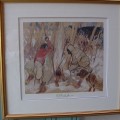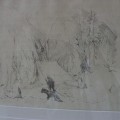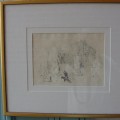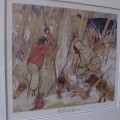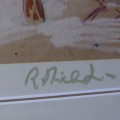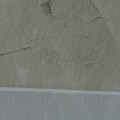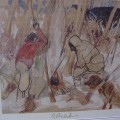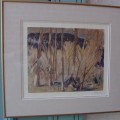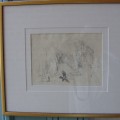René Richard
Né en Suisse, sa mère vient d'une famille d'artistes et son père était un graveur réputé, qui voit des ouvertures pour sa famille en venant s'établir au Canada avec sa famlle. Après des séjours au travers le Canada seul ou avec les siens, vint un jour où il prit son canot et descendit la rivière MacKenzie sur les berges de l'océan Artique. Sa vie changea dès ce moment. Le reste est désormais légende, propre à notre pays. On oublies l'histoire et devrions plutôt se concentrer sur ses voyages intérieurs, dans le grand nord Canadien, et des régions lointaines ou plus proches de nous tel, Charlevoix, où il vécut plusieurs années, et ces voyages qui sont devenus images, qu'il nous lègue, par ces centaines de petits joyaux, qui font maintenant la joie des amateurs d'art brut, et collectionneurs. On remercie M.Colin J. Macdonald pour son travail de recherches qui font références. Voir texte anglais ci bas. Merci à vous.
Born at Chaux-de-Fonds, Switzerland, his mother had come from a family of artists and his father was an engraver who sought new opportunities in Canada. They came to Montreal, Canada, where they lived for a few years and where René received his elementary education. The Richards then moved to north western Alberta at Cold Lake, where René's father established a general store and trading post. René worked for his father at different times until he was twenty-eight. He supplemented his living by trapping. In his early teens he made his first trips into the bush. By 1923 he had paddled his canoe down the Mackenzie River to the shores of the Arctic Ocean where he had joined groups of Indians and Eskimos in various hunting expeditions. He remained in the north for about three years during which period he found himself picking up bits of birch bark and making crude sketches with burnt twigs. His appreciation of the wonderful sights in the northern landscape, bathed in the varying light, further enhanced by the skies painted with nothern lights, gave him the desire to record what he saw and to become an artist. He realized he had to save money to study art and set to trapping with great determination. He caught the white fox (valued for its fur) on the barren lands near the western Arctic Ocean. He returned south laden with enough furs to raise $3,000. He next approached his brother, Paul-Jean Richard, a former student of the Sorbonne, Paris, for advice. His brother, now a professor of French at the University of Winnipeg, gave him the name of Pierre Dupuy, a member of the Canadian Legation in Paris. René arrived in Paris in the autumn of 1927. He went to the Legation where he found Dupuy. Dupuy in turn placed him in the able hands of Clarence Gagnon. Gagnon advised him to go out into the streets and parks of the city to paint those things that interested him most and return to him for criticism. Richard spent most of his three years painting and receiving criticism from Gagnon learning and progressing greatly. He visited galleries and museums and studios of established artists. When his funds were exhausted, he applied for a student bursary at one of the art schools but was turned down because of his age (30 years) and was obliged to return to Cold Lake, Alberta, in 1930. There were few jobs to be had so René spent the next four years working in mining camps in northern Manitoba while painting whenever he could. In the summers he journeyed by canoe to distant points for instance down the Churchill River to Hudson Bay. Another trip took him 500 miles along the Saskatchewan River through 50 rapids by raft. His experiences as a hunter, trapper and voyageur would make good material for a book. In 1940 on the suggestion of Clarence Gagnon, he settled at Baie St. Paul, Quebec, where he met and married Blanche Simon, one of Quebec's finest and most original designers and weavers. They lived in the old Simon homestead where Blanche became René's most valued and faithful critic. From Baie St. Paul, Richard set out on many more trips this time to various parts of Quebec including Ungava at the Chubb Crater and elsewhere in Canada as well. Viewing his work in 1945 The Gazette critic noted, "The collection reveals him as a painter of directness and force with a good color sense and skilled in arranging his pictorial material. In the main his subjects are handled in a broad, sweeping manner, his vistas are wide, his mountains are solidly based and the impresion of open air is convincingly conveyed. These works express the love this artist has for the open country, andhe has seen much of it of differing kinds for, prior to settling at Baie St. Paul and marrying Blanche Simon, he made many trips along the Mackenzie and Saskatchewan rivers, painting as far north as Lake Winnipeg and James Bay. To those who like nature in the rough these paintings should appeal .... His work in charcoal, tinted paper being employed, shows a real liking for this medium. The line is crisp, the masses well placed and skill is shown in eliminating non-essentials. The subjects of this group range from Northern Alberta to Charlevoix. In a sketchier manner he successfully employs crayons . . . ." By the 1960's Richard had become well known and many feature articles were written about him right up until his death. One of his paintings was selected for the cover of the annual Quebec Telephone Company directory. Describing Richard in 1971, Rita Daguillard noted, "Today Richard is a tall, lean giant whose calm bearing gives little hint of the struggle that led him to his present comfortable reputation and position, and he divides his time between painting and tending the lush garden of the nineteenth century farmhouse in which his wife was born." There were no children by their marriage. Richard died at the age of 86 at Baie-Saint-Paul (1982). He received the Order of Canada prior to his death He is represented in the collections of Queen Elizabeth 11, England; The National Gallery of Canada, Ottawa; Musée du Québec, Quebec City, Montreal Museum of Fine Arts; Laval University, Quebec City; Department of External Affairs and elsewhere, His canvases range from small field sketches to large 48" x 41" paintings. His solo shows include: L'Art Français, Mtl. (1945) (1946) (1948) (1950) (1952) (1975) (1981); Eaton's, Tor. (1946); Recreation Centre, Arvida (1946) (1950) (1952); The Arts Club, Mtl. (1948); Palais Montcalm, Quebec City (1949) (1950) (1951) (1955) (1957) (1958); Galerie L'Art Canadien, Chicoutimi (1955); Hélène de Champlain Restautant, Mtl. (1958); Centre D'Art, Shawinigan, Que. (1961); City Hall, Arvida (1961); Galerie Zanettin, Que. (1962); Mount Royal Art Centre, Mtl. (1963) (1967); Les Compagnons de l'Art, Rimouski (1963); Walter Klinkhoff Gallery, Mtl. (1964); Galerie Morency, Mtl. (1964); Musée du Québec, Quebec City (1967) (1978); Municipal Library, Ste-Foy, Que. (1971); Musée Régional, Rimouski (1973); Studio des artistes canadiens, Que. (1974); Art & Style Gallery, Md. (1974); Michel de Kerdour, Mtl. (1974); Laval University, Que. (1980); La Galerie Claude Lafitte, Md. (1982)'; La Galerie Basque, Rimouski, Que. (1982); Musée Laure-Conan, La Malbaie, Que. (1982) and elsewhere. His painting "Along Great Slave Lake" was reproduced with eleven artists' works on Canadian 30 cent stamps, to commemorate Canada Day, 1982.
« Retour / Home

